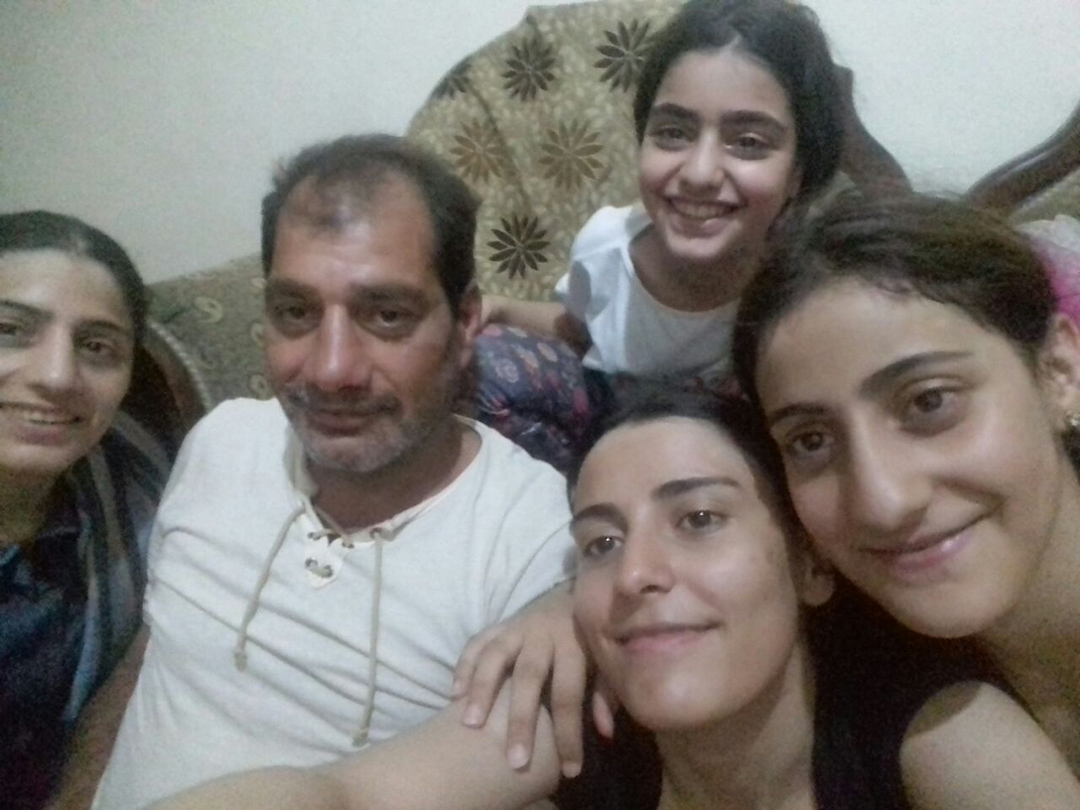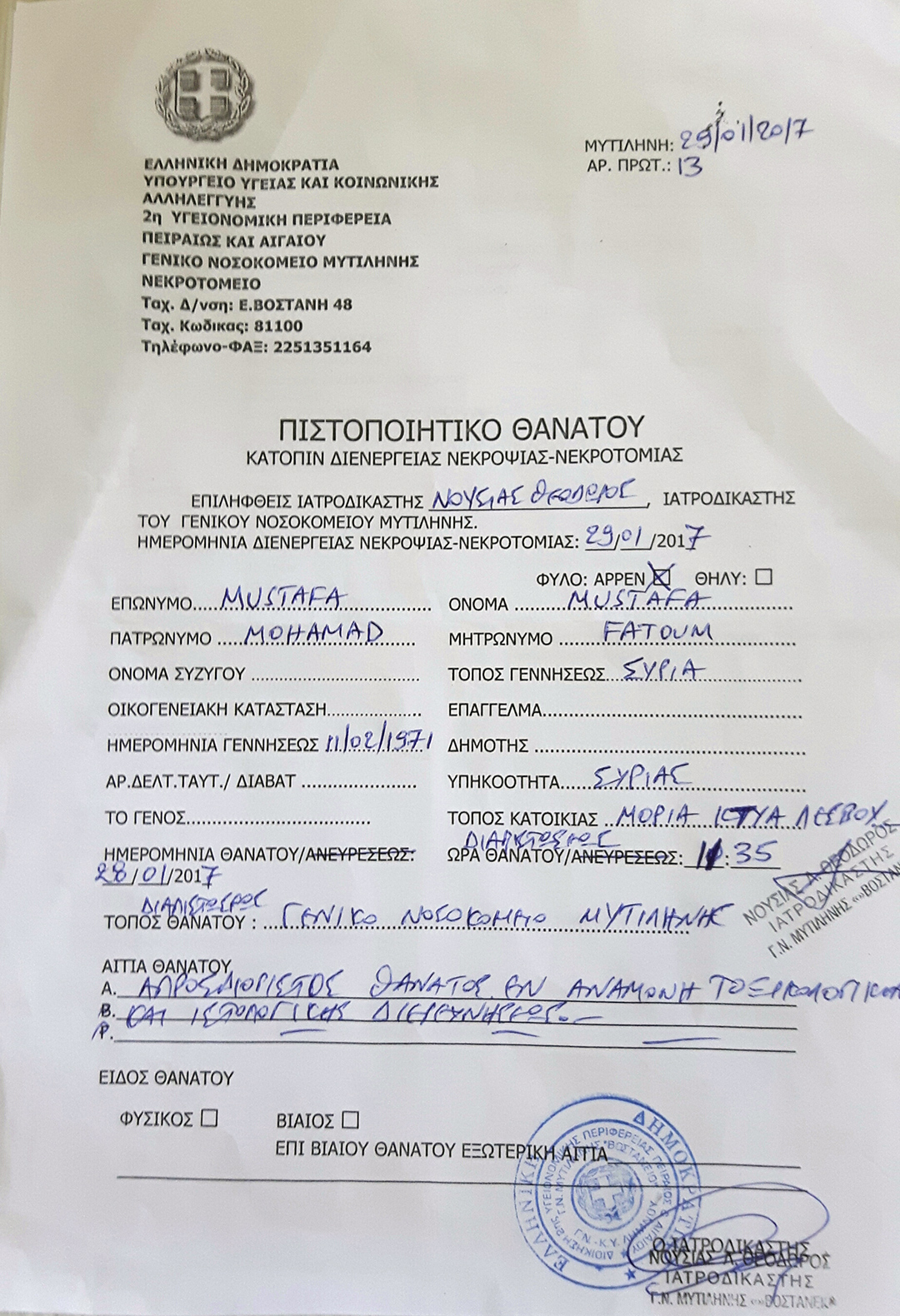One week, three dead, zero accountability
In January, three people died in their sleep at Moria migrant camp. Ten months later, their families are still looking for answers.

SPECIAL REPORT 29.11.2017 • REPORTING: YIANNIS PAPADOPOULOS • PHOTOGRAPHS: GIORGOS MOUTAFIS
Last winter, Mustafa Mustafa, a refugee from Syria, sent a 46-second Whatsapp voice message to his sister, who lives in the Netherlands. It was the last time she would hear her brother’s voice.

“It is degrading here. Gangs and the mafia steal from people on the island and in the camps and the police do not get involved. You can get stabbed and the police won’t do anything,” Mustafa said. A few days later, he was found dead in his tent.
A cell phone video shot by a migrant in the morning of January 28 shows 46-year-old Mustafa lying on the ground as doctors try to revive him. It was in vain. Mustafa had died in his sleep.
A postmortem examination by forensic expert Theodoros Nousias found that the “cause of death was not determined pending the toxicology and histological tests.”
‘Like charred wood’
Four days earlier, Ahmed Mohamed Abdelaziz Elgamal, a 20-year-old man from Egypt, had died in the same tent. And on January 29, another young man from Pakistan also went to sleep but did not wake up the next day. Dimitris Patestos, a cardiologist who worked at that time in Moria as a medical coordinator for Doctors of the World (Medecins du Monde), says all indications pointed to carbon monoxide poisoning.
“They smelled like charred wood. Like they had been inside a fireplace,” he recalls.
In early January, the summer tents were covered in snow. Mustafa sent a picture of snow-blanketed Moria to his sister. “The cold has destroyed me,” he said in a message.

Moria refugees were at that time trying all sorts of ways to keep themselves warm. Patestos used to see them burning wood until it charred inside oil cans which they then brought inside their nylon tents. Despite warnings from medics, they defied the risks.
Those three deaths, which took place over the course of one week, underscored the Greek authorities' inability to deal with the refugee population in Moria. However, 10 months later, no one has been held responsible for these deaths. Today, Moria continues to operate at overcapacity (more than 6,000 people are accommodated in a facility built for 2,330) and the camp yet again seems unprepared for winter.
Kathimerini conducted a series of interviews with doctors, witnesses and the relatives of one of the three victims that reveal the foot-dragging of Greek authorities who are yet to investigate the tragedy.
From Germany to Moria
Mustafa was born February 1971 in Aleppo, Syria, into a family of 11 siblings (six boys and five girls). In 1998 his wife, Mariam, gave birth to their first child. After that, they had five more.

He worked at a furniture factory and made a good name as a craftsman. He had bought a piece of land and planned to build his own home, when the civil war arrived in his neighborhood. In late 2014 he and his family were displaced near the border with Turkey. A few months later he decided to cross into Europe.
He traveled on his own, with money given to him by two of his brothers. “He wanted to reach Germany and then pursue family reunification,” his sister, Amal Mustafa, says over the phone. “He made it in mid-2015. He called me from Germany and said that he had been granted a three-year residence permit,” she says. The Balkan route was still open, Greece was a transit country and Mustafa managed to reach his destination in just a few days, along with hundreds of thousands of other refugees.
Kathimerini has seen documents bearing Mustafa’s name and a photograph that appear to have been issued by the authorities of Mecklenburg-Vorpommern, a federal state in northern Germany, as well as a debit card issued by a German bank in his name.

The Federal Office for Migration and Refugees in Germany could not confirm that Mustafa had been awarded refugee status or whether the aforementioned documents are authentic, citing rules on personal data protection.
Nevertheless, the stamp on Mustafa’s residence permit (issue date February 2, 2016) shows that the Syrian had settled in Wismar. A picture seen by Kathimerini, depicts Mustafa posing next to Tauzieher (German for Tug of War), a 1934 sculpture by Karl-Henning Seemann, next to the Church of St Marien.

“He had talked to me about the difficulties he faced there,” his sister says. “He had trouble communicating with the locals, and there were not many Arabic-speaking people,” she says.
Officials at Greece’s Ministry of Migration and the Ministry of Citizens’ Protection did not respond to questions by Kathimerini about how Mustafa, who appears to have reached Germany in 2015, ended up in Moria. His brother, Hossein Mustafa, says that the 46-year-old decided to return to Greece after he found out that family reunification would be delayed. His plan was to meet with one of his sons in Greece after the latter had crossed from Turkey. His sister Amal says that during a check on Mustafa, Greek authorities questioned the authenticity of his German documents, classified him as a newcomer and suggested that he resettle in another European country. Mustafa however believed that doing so would take too much time, she says.
Having run out of money, he started to despair. “Every time I go up to them and ask them, ‘What’s going on?’ they tell me to come back in two days. Here in Greece everyone is a liar. No one helps anybody. Not even the United Nations,” Mustafa can be heard telling his sister in a voice message sent from Greece. According to Amal, Mustafa asked to return to Turkey and he was sent to Moria. Greek authorities have neither confirmed nor refused her claim.
Mustafa’s siblings found out about his death via Facebook when a refugee posted photos of two victims, the Syrian and the Egyptian, with a message that said: “God forgive the living and the dead. This day I heard the news about two beloved persons. Friends and brothers who died in Moria camp of tuberculosis.”

“The news was a surprise to us. He was tough and used to the cold. Before he left Syria, he had spent a long time in a camp. An acquaintance told us that the previous evening they ate together and he was fine,” Amal says.
Hossein traveled from Sweden, where he lives, to Lesvos, looking for answers. He had stayed in Greece in 1994 and he speaks the language. He thought he would come up with an explanation. However, no one was able to tell him what the cause of death was.
Lesvos police say that the case file on the three deaths has been passed on to the prosecutor, but the forensic report is still pending. Nousias, the coroner of Lesvos, did not tell Kathimerini if he had received the toxicology test results. In cases where victims had died of carbon monoxide poisoning in the past, results were available in two months (in the 2013 case of two students who died in Larissa) or three months (in the 2008 case of a Greek couple on Samothraki).

Forensic expert Pavlos Pavlidis was in charge of the Samothraki case, along with another colleague. He says the time it takes to die of carbon monoxide poisoning would not be the same for every person. The duration can depend on a person’s age and physical condition. This explains the fact that other people survived, although they were living in the same tents as the victims.
‘They forgot us’
“We ought to quickly investigate the cause of deaths in Moria and to take actions that will make the situation more controllable. We cannot disconnect these deaths from the overcrowding at the Reception and Identification Center,” Minister of Immigration Policy Yiannis Mouzalas said on January 30. Despite this, 10 months later, another ministry official told Kathimerini that direct responsibility for the incident cannot be ascribed to any persons in the state apparatus, because the report of the medical examination is still pending.
Last June, NGOs Pro Asyl and Refugee Support Aegean said in a statement that there is a lack of political will to investigate the deaths in Moria. They stressed that, according to witnesses, a few days prior to the deaths, insulation material was added to the tents, which might have led to the containment of the hazardous fumes inside them. However, according to the NGOs, this hypothesis was never investigated by authorities.

Hossein Mustafa stayed on Lesvos for approximately one week, until he could identify his brother's body and complete the necessary procedures for its repatriation. In an email sent to the Greek consular authorities in Berlin, which Kathimerini has seen, he asked why his brother ended up in Moria when he had a residency permit in Germany. “Now he is dead and we need to take him from the hospital in Mytilene. We need your help,” he wrote.
The only ones who stood by his side until the end were volunteers from the Lesvos Solidarity group. On their own initiative a funeral home was found, Turkish consular authorities in Rhodes were notified, and Mustafa's last journey was organized. At the same time, Ahmed Mohamed Abdelaziz Elgamal's uncle went to Lesvos, received his relative's body and transported it to the village of Demeirah in Egypt.

On March 14, Mustafa's body arrived in Syria, where it was received by his relatives.
“One by one they died in Moria, but since then no one has told us what happened,” says Hossein. “They forgot us.”
DEATHS IN MORIA
Ten months later no answers
Reporting- Video editing: YIANNIS PAPADOPOULOS
Photographs- Camera: GIORGOS MOUTAFIS
For Kathimerini eKathimerini.com.
Wednesday 29.11.2017
